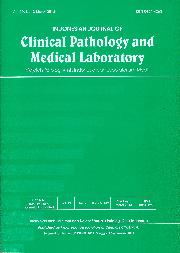Indonesian Journal of Clinical Pathology and Medical Laboratory
ISSN 0854-4263
Vol. 19 / No. 2 / Published : 2013-01
Related with : Scholar Yahoo! Bing
Original Article :
C-x-c receptor 4 (cxcr4) in metastasis of breast cancer
Author :
- I Wayan Sudarsa*1
- I WayanPutuSutirtaYasa*2
- Divisi Bedah Onkologi, Departemen Bedah FK Unud/RSUP Sanglah Denpasar,Pascasarjana Universitas Udayana
- Departemen Patologi Klinik FK Unud/RSUP Sanglah Denpasar, Pascasarjana Universitas Udayana
Abstract :
The chemokine receptors CXCR4 (chemokine C-X-C motif receptor 4) and its ligand (stromal derived factor-1/SDF-1 or chemokine motif ligand 12/ CXCL12) play an important role in cancer invasion and metastasis. The spread of breast cancer follows a nonrandom metastatic pattern typically involving spread of tumor to regional lymph nodes, lung, liver, and/or bone marrow. The ligand for CXCR4, SDF-1/CXCL12, is highly expressed by stromal fibroblasts within these tissues. The chemokine receptors CXCR4 is structurally related to chemokine receptor belonging to the superfamily of the seven transmembrane G-protein coupled receptors. In contrast to normal breast tissue, breast cancer cells typically express high levels of functional CXCR4 receptors that can direct chemotaxis and invasive responses. Expression of SDF-1/ CXCL-12 in turn, promotes the progression of breast cancer by directly enhancing tumor-cell growth and by recruiting endothelial progenitor cells that are required for tumor angiogenesis. High-level expression of CXCR4 on neoplastic cells is associated with relatively poor overall survival and bad prognosis in patients with breast cancer. The promising results in the preclinical tumor models indicate that CXCR4 antagonists may have to reduce the spread of cancer that is called anti tumor activity in patients with breast cancer. The chemokine receptors CXCR4 antagonists, although initially developed for treatment of acquired immunodeficiency diseases syndrome (AIDS), actually may become effective agents as a molecular targeted therapy for breast cancer. Reseptor kemokin C-X-C(CXCR4) dan ligandnya (stromal derived factor-1/SDF-1 atau chemokine motif ligand 12/ CXCL12) memegang peran penting dalam proses kanker memasuki (invasi) dan menyebar (metastasis). Penyebaran kanker payudara mengikuti pola metastasis yang bersifat non random yang biasanya secara khusus menuju ke kelenjar getah bening regional, paru, hati dan atau ke sumsum tulang. Protein SDF-1/CXCL12 yang merupakan ligand dari CXCR4 diekspresikan secara berlebihan di organ tersebut. Secara struktural reseptor kemokin CXCR4 merupakan keluarga kelompok reseptor the seven transmembrane G-protein coupled receptors. Berbeda dengan sel jaringan payudara normal, sel kanker payudara secara khusus mengekspresikan reseptor CXCR4 dengan kadar yang tinggi, sebagai respons langsung terhadap kemotaksis dan penyerbuan. Sebaliknya ekspresi SDF-1/CXCL12 dapat merangsang kemajuan kanker payudara secara langsung dengan meningkatkan pertumbuhan sel dan dengan menarik endothelial progenitor cells yang diperlukan untuk angiogenesis tumor. Sel kanker payudara yang mengekspresikan reseptor kemokin CXCR4 yang tinggi berhubungan dengan ramalan jalannya penyakit yang relatif buruk dan angka bertahan hidup yang rendah di penderita kanker payudara. Kajian preklinik di model sel tumor menunjukkan bahwa pemberian antibodi monoklon antagonis CXCR4 beraktivitas mengurangi penyebaran kanker, sehingga disebut sebagai anti kanker dan menjanjikan di masa yang akan datang pada pengobatan kanker payudara. Zat antagonis CXCR4 walaupun pada awalnya dikembangkan untuk pengobatan penderita human immunodeficiency virus (HIV) atau acquired immunodeficiency diseases syndrome (AIDS), kenyataannya juga dapat dipakai sebagai molecular targeted therapy terhadap kanker payudara.
Keyword :
CXCR4, SDF-1/CXCL12-CXCR4 axis, breast cancer, metastasis,
References :
1. Jemal A, Murray T, Ward E, Samuels A, Tiwari RC, Ghafoor A, et al,(2009) Cancer Statistics USA : CA Cancer J Clin
Disis ML,(2005) Global Role of the Immune System in Identifying Cancer Initiation and Limiting Disease Progression USA : J Clin Oncol
3. Bracke ME, De Maeseneer D, van Mark V, Derycke L, Vanhoecke B, De Wever O, et al,(2008) Cell Motility and Breast Cancer Metastasis London : Springer
Burger JA, Kipps TJ,(2006) CXCR4: A Key Receptor in the Crosstalk Between Tumor Cells and their Microenvirontment USA : Blood
5. Liu Y., Ji R, Li J, Gu Q, Zhao X, Tao Sun T, et al,(2010) Correlation Effect of EGFR and CXCR4 and CCR7 Chemokine Receptors in Predicting Breast Cancer Metastasis and Prognosis USA : Journal of Experimental & Clinical Cancer Research
Archive Article
| Cover Media | Content |
|---|---|
 Volume : 19 / No. : 2 / Pub. : 2013-01 |
|












